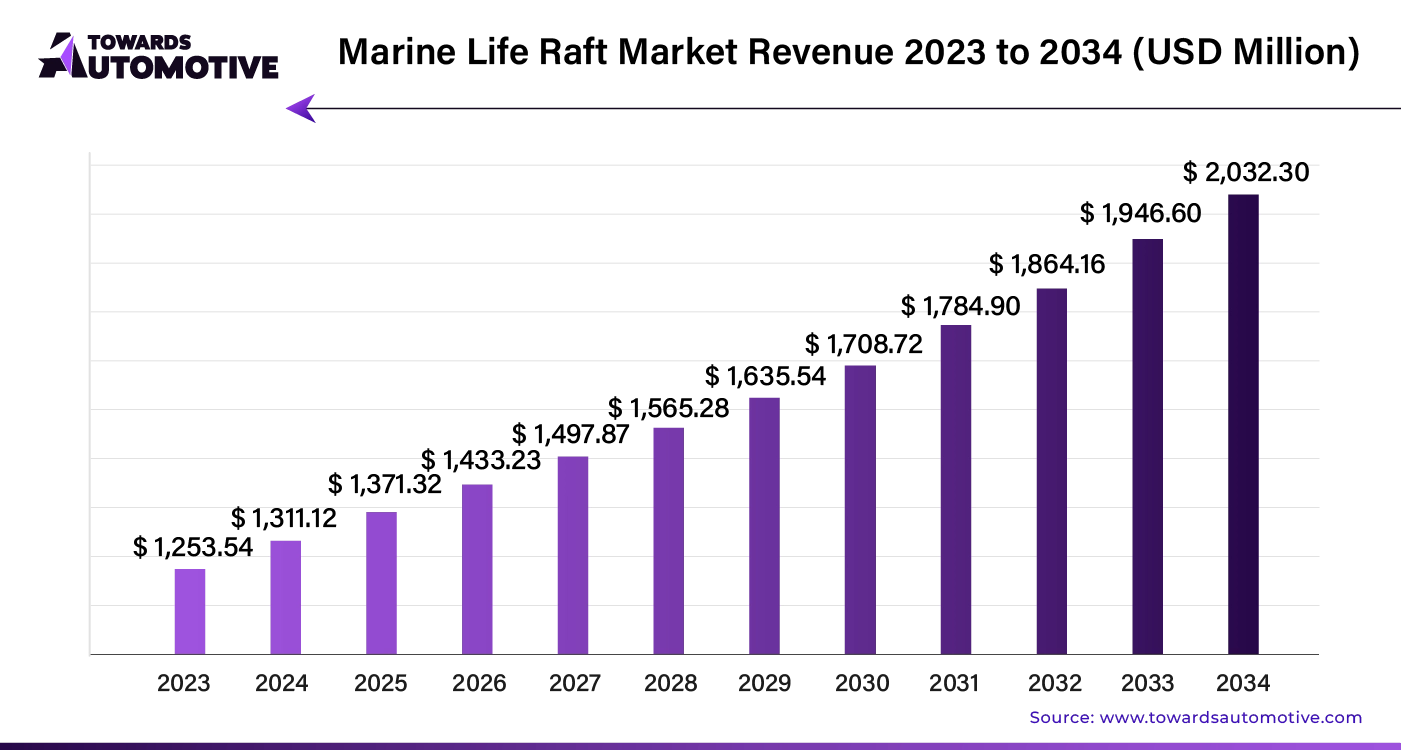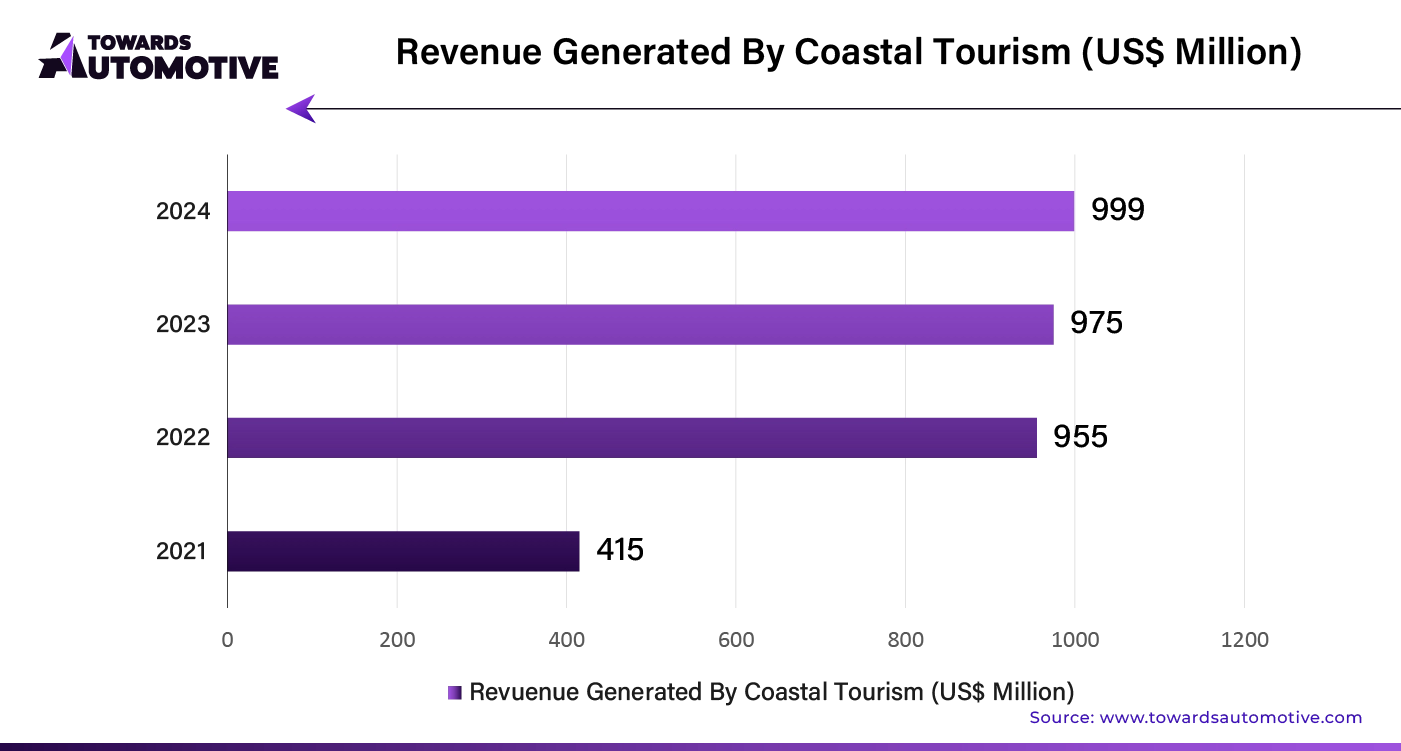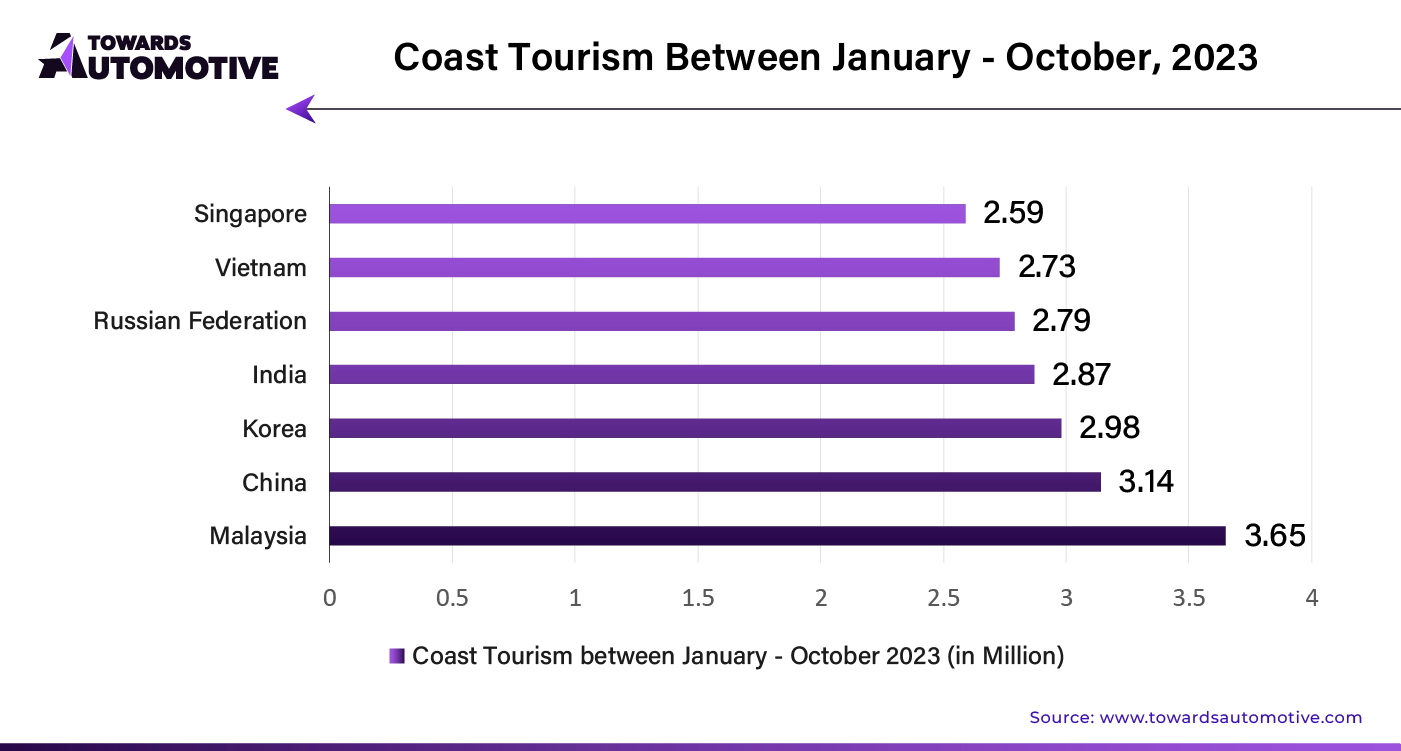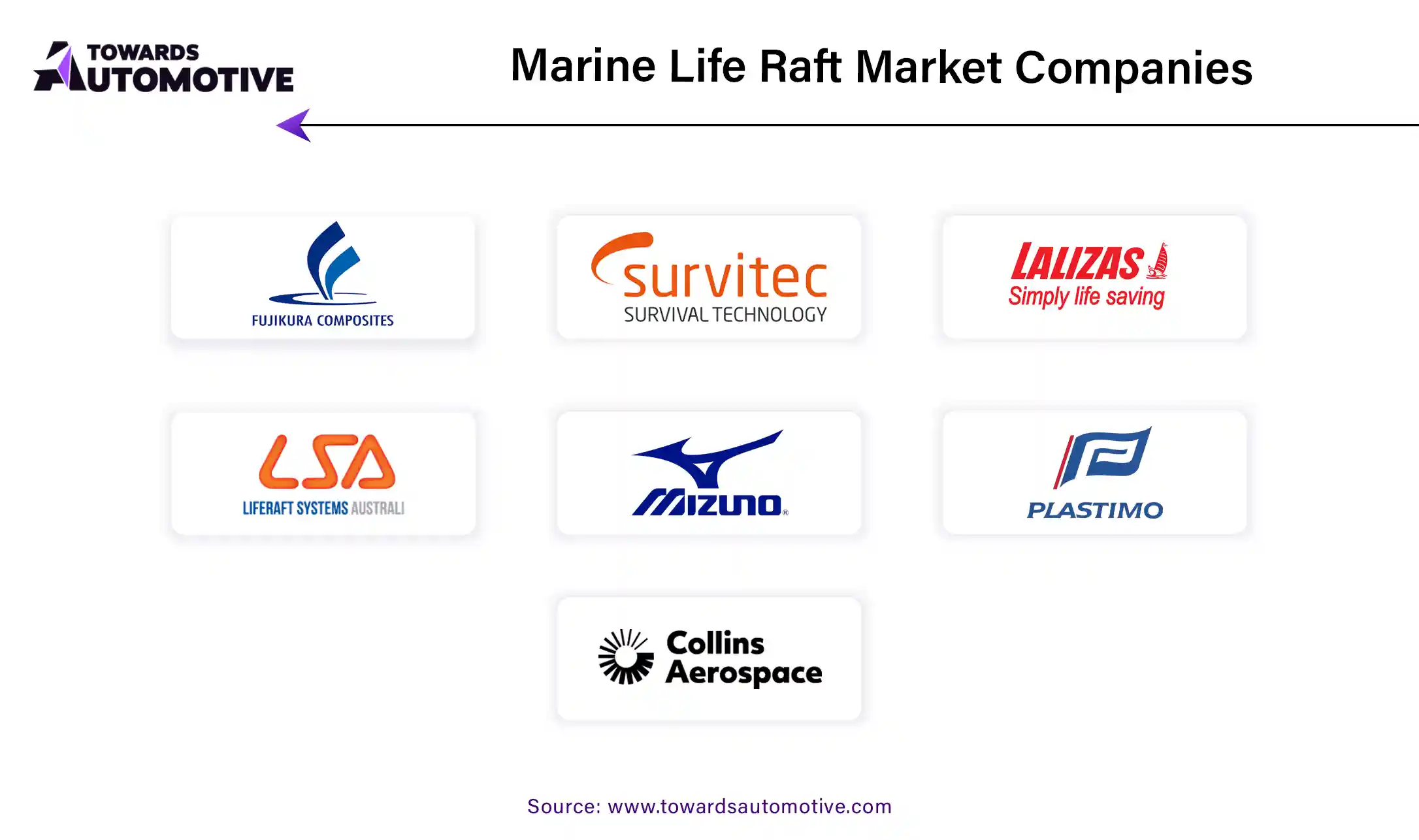March 2025

Senior Research Analyst

Reviewed By
The marine life raft market is forecast to grow from USD 1,371.32 million in 2025 to USD 2,032.30 million by 2034, driven by a CAGR of 4.54% from 2025 to 2034.

As market trends evolve, ships are increasingly opting for compact and lightweight marine life rafts to optimize space and enhance buoyancy. These rafts now feature smart technology that boosts emergency response capabilities and accelerates rescue operations. Strict international safety standards are driving demand for certified marine life rafts that comply with these regulations. Yacht owners and recreational boaters are also prioritizing safety, leading to a rise in the need for reliable marine life rafts. Additionally, with growing environmental concerns, manufacturers are creating eco-friendly rafts made from recycled materials and sustainable production methods. The automotive market valued at USD 4,070.19 billion in 2023, is experiencing growth and is projected to surpass USD 6,678.28 billion by 2032, with a significant CAGR of over 5.66%.
Marine life rafts are increasingly vital due to stringent maritime safety regulations that ensure vessels meet international safety standards. Growing awareness of maritime accidents highlights the need for effective emergency evacuation solutions. As global commercial shipping expands, the demand for marine life rafts rises to enhance crew and cargo safety. Ship owners invest in life-saving equipment to comply with regulations and protect their crews. Advances in design and manufacturing make marine life rafts more durable and reliable, driving their adoption among maritime stakeholders.
The increasing trend of coastal tourism and the surge in adventure and water sports activities have significantly raised the need for stringent safety measures and reliable equipment.

Marine life raft manufacturers face significant challenges in meeting international standards for buoyancy, capacity, and reliability. To ensure functionality during emergencies, life rafts require robust construction and rigorous testing. Manufacturers must address issues related to access, inflation systems, and stowage to enable quick and efficient deployment. Passengers and crew are given thorough instructions on operating, maintaining, and inspecting life rafts to ensure preparedness. Additionally, addressing space constraints, uneven weight distribution, and accessibility issues is crucial for the effective installation and storage of life rafts on ships.
Artificial Intelligence (AI) is poised to revolutionize the Marine Life Raft market by enhancing safety and operational efficiency. AI-driven technologies will enable real-time monitoring of life rafts, significantly improving their performance and reliability. Advanced sensors and AI algorithms will facilitate predictive maintenance, ensuring that life rafts are always in optimal condition and reducing unexpected failures.
AI can also optimize design and manufacturing processes, making life rafts more durable and cost-effective. Machine learning algorithms will analyze data from various sources, leading to smarter design choices and innovations in materials. This approach will help manufacturers meet evolving safety standards while managing costs effectively.
Additionally, AI will enhance emergency response capabilities. Intelligent systems can guide users through survival procedures, offer real-time updates, and improve communication with rescue teams. This will not only boost consumer confidence but also drive demand for advanced life raft solutions.
The supply chain for the marine life raft market operates through a streamlined process to ensure timely delivery and quality assurance. It begins with raw material procurement, where suppliers provide essential components like fabrics, inflatable materials, and safety equipment. Manufacturers then assemble these materials into life rafts, adhering to stringent safety standards.
Next, finished life rafts undergo rigorous quality control tests to meet regulatory requirements. Once approved, they are packaged and distributed to various channels. Distributors and wholesalers play a crucial role in this phase, ensuring that life rafts reach retailers and end-users efficiently.
Retailers stock the products, providing them to consumers and maritime operators. They rely on timely replenishment from distributors to maintain adequate inventory levels. Finally, after-sales support, including servicing and replacement, is handled by specialized service providers.
Overall, the marine life raft supply chain emphasizes coordination between suppliers, manufacturers, distributors, and retailers to ensure product availability and compliance with safety regulations. This efficient process guarantees that life rafts are ready for deployment whenever needed, enhancing safety at sea.

The Marine Life Raft market ecosystem is primarily driven by several key components and industry players. The main components include life rafts, inflation systems, storage containers, and survival kits. Life rafts are designed to keep individuals safe in emergencies at sea, featuring essential elements like buoyancy and stability. Inflation systems ensure the rafts are quickly and effectively deployed, while storage containers protect rafts until needed. Survival kits, often included with rafts, provide necessary supplies for survival.
Leading companies contribute to the market by offering innovative solutions and enhancing safety standards. Companies such as Viking Life-Saving Equipment, Survitec Group, and Zodiac Milpro provide a range of high-quality life rafts with advanced features. Viking Life-Saving Equipment focuses on durable, user-friendly rafts with cutting-edge inflation systems. Survitec Group specializes in integrated survival systems, ensuring comprehensive safety solutions. Zodiac Milpro offers rugged, reliable rafts suitable for extreme conditions.
These companies drive market growth by continuously improving technology, expanding product offerings, and adhering to stringent safety regulations, ensuring that marine life rafts meet the highest standards for maritime safety.
United States
Marine life rafts are essential safety equipment for recreational boating, fishing, and commercial shipping in the United States. The market is projected to grow at a CAGR of 3.50% from 2024 to 2034. The widespread popularity of recreational boating increases the demand for dependable safety gear, making marine life rafts a key consideration for boaters and yacht owners.
Canada
In Canada, the marine life raft market is anticipated to expand at a CAGR of 4.60% over the forecast period. Advances in shipbuilding and marine technology are driving the adoption of state-of-the-art life rafts. Canada's prominent maritime industry and growing shipbuilding sector make its marine life rafts a crucial part of global ship safety.
United Kingdom
The United Kingdom's marine life raft market is expected to grow at a CAGR of 3.10% from 2024 to 2034. Stringent maritime safety regulations enhance the need for life rafts. The focus on coastal defense and search and rescue operations highlights the importance of marine life rafts in ensuring maritime safety.
China
China's rapid economic development and expanding maritime activities are increasing the demand for marine life rafts, essential for protecting crew and passengers. The market is projected to grow at a CAGR of 4.00% during the forecast period. Improved safety awareness and educational initiatives contribute to the rising adoption of marine life rafts.
Japan
Japan is set to experience the highest growth in the marine life raft market, with a CAGR of 5.10% from 2024 to 2034. Emphasis on maritime safety and adherence to international regulations make life rafts critical. The modernization of Japan’s aging fishing fleet drives the need for updated safety equipment, including marine life rafts.
In 2024, inflatable rafts are projected to hold a substantial market share of 63.8%. The segment for rafts designed for more than 18 people is anticipated to account for 46.2% of the market from 2024 to 2034.
The demand for marine life rafts is shaped by shifts in maritime safety regulations and standards. Changes in ship routing, rising maritime activities, and advancements in safety technology all influence this demand. Inflatable rafts are expected to capture a 63.8% market share by 2024.
Businesses are upgrading their safety equipment with new materials, designs, and features. Increased awareness of environmental issues and regulations on maritime pollution are pushing companies towards greater compliance and sustainability.
Rafts with a capacity for over 18 people are leading the marine life raft market. These rafts are essential for commercial vessels, offshore platforms, and large maritime operations.
High-capacity rafts provide enhanced safety for large groups in emergencies. They are equipped with advanced features such as GPS tracking, automatic inflation systems, and complete survival kits, facilitating rapid deployment and effective emergency responses. This segment is expected to hold a 46.2% market share during the forecast period.
The marine life raft industry features a diverse range of players, from large corporations to smaller firms, all striving to capture market share. Companies are increasingly integrating advanced technologies into their offerings to stay competitive.

By Product Type
By Capacit
By End User
By Region
March 2025
February 2025
February 2025
September 2024
Dr. Arjun Patel is a distinguished expert in the automotive industry, holding advanced degrees in Automotive Engineering and Mechanical Engineering. His expertise spans automotive market dynamics, technological advancements, and sustainable practices. Dr. Patel excels in conducting in depth research and analysis on market trends, consumer preferences, and the economic implications within the automotive sector. He is renowned for his insightful publications on topics such as electric vehicles, autonomous driving technologies, and the evolution of sustainable transportation solutions. Dr. Patels research contributions have significantly advanced understanding in the field, earning him recognition as a leading authority in automotive research and analysis.
We offer automotive expertise for market projections and customizable research, adaptable to diverse strategic approaches.
Contact Us